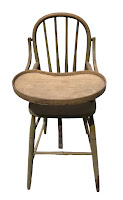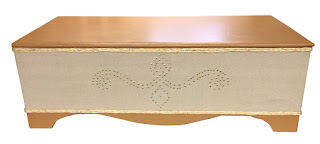 |
| Chair After |
 |
| Chair Before |
And to make matters even more time-consuming, the staples were quite rusty, which made them a bit tougher to remove. This chair may have been in a damp environment, hence the rusty staples, but the fabric had no mold or odors, so despite the dampness, it was dry and odorless.
Removing the fabric is the opposite of putting it on. I removed the welting on the back first before removing the entire back itself. I kept the pieces in tact as I was planning on using them as templates. This is much easier than making the patterns without the original pieces, which I’ve also done. For this particular style of chair having those template pieces was invaluable. I had to carefully transfer the markings for the fluted back and button positions from the old fabric to the new fabric.
Using a heat removable marker, I transferred the lines to the new fabric. The back consisted of four layers; the outer fabric, the batting, the 1/4” foam and the liner which is the very back fabric (I used muslin), not seen when the chair is put together. The challenging part of this process was stitching all those layers together while keeping them from moving too much. This took the better part of the afternoon to accomplish. The chair also had fabric covered buttons which had to made individually as I don’t own an automatic button maker. (....some day...).
After I had the seat all done, I began the slow process of attaching the thickly padded back. Starting at the top and temporarily attaching it to the center back, I worked the layers through the bottom wood structure of the chair and attaching it to the lower portion of the wood. All this is not seen once the chair is done. Once I was sure the backing was lined up, I finished attaching it securely. After the front of the back was installed, I attached the very back which covers up the interior of the chair. I covered the back with Dacron batting then used tack strip, which attaches to the wood of the chair all the way down to the arms, then the fabric is tucked between the tacks and folded then hammered with a rubber mallet, attaching it firmly to the back. At the juncture of the arms, I attached the rest of the fabric with staples as that part would be covered with welting.
I then attached the welting below where the tack strip ended, curving around the arms and again on the top curve of the front legs. This is decorative and effective way to finish the chair while covering any raw edges of the fabric. Many chairs have tacks that are used for this purpose, but I prefer welting (also called piping or cording) because once you remove the original tacks, it is hard to apply new ones without defaulting to the old holes, which don’t always line up. Many times the tacks break or bend and can’t be used, especially on very hard wood such as maple or oak. Welting is a great alternative and a cleaner look.
I loved the lines an shape of this chair and boy, was it comfortable to sit on when it was finished!
















































